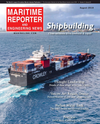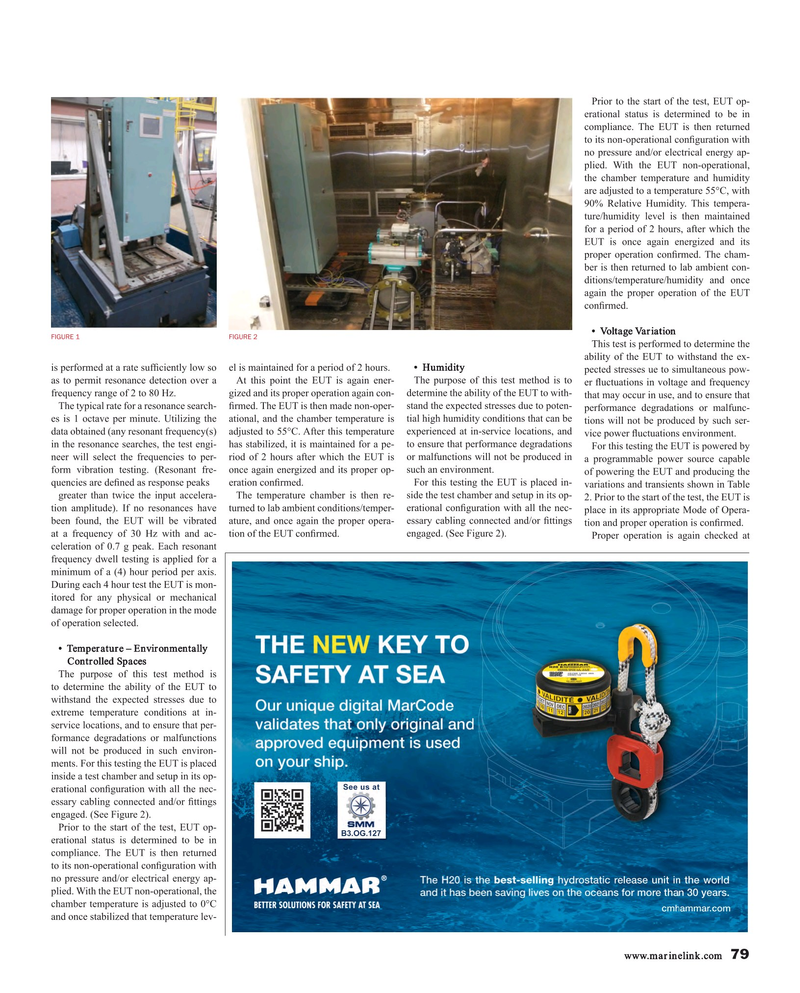
Page 79: of Maritime Reporter Magazine (August 2018)
The Shipyard Edition
Read this page in Pdf, Flash or Html5 edition of August 2018 Maritime Reporter Magazine
Prior to the start of the test, EUT op- erational status is determined to be in compliance. The EUT is then returned to its non-operational con? guration with no pressure and/or electrical energy ap- plied. With the EUT non-operational, the chamber temperature and humidity are adjusted to a temperature 55°C, with 90% Relative Humidity. This tempera- ture/humidity level is then maintained for a period of 2 hours, after which the
EUT is once again energized and its proper operation con? rmed. The cham- ber is then returned to lab ambient con- ditions/temperature/humidity and once again the proper operation of the EUT con? rmed.
• Voltage Variation
FIGURE 1 FIGURE 2
This test is performed to determine the ability of the EUT to withstand the ex- is performed at a rate suf? ciently low so el is maintained for a period of 2 hours. • Humidity pected stresses ue to simultaneous pow-
The purpose of this test method is to er ? uctuations in voltage and frequency as to permit resonance detection over a At this point the EUT is again ener- frequency range of 2 to 80 Hz. gized and its proper operation again con- determine the ability of the EUT to with- that may occur in use, and to ensure that
The typical rate for a resonance search- ? rmed. The EUT is then made non-oper- stand the expected stresses due to poten- performance degradations or malfunc- es is 1 octave per minute. Utilizing the ational, and the chamber temperature is tial high humidity conditions that can be tions will not be produced by such ser- data obtained (any resonant frequency(s) adjusted to 55°C. After this temperature experienced at in-service locations, and vice power ? uctuations environment.
in the resonance searches, the test engi- has stabilized, it is maintained for a pe- to ensure that performance degradations
For this testing the EUT is powered by neer will select the frequencies to per- riod of 2 hours after which the EUT is or malfunctions will not be produced in a programmable power source capable form vibration testing. (Resonant fre- once again energized and its proper op- such an environment.
of powering the EUT and producing the quencies are de? ned as response peaks eration con? rmed. For this testing the EUT is placed in- variations and transients shown in Table greater than twice the input accelera- The temperature chamber is then re- side the test chamber and setup in its op- 2. Prior to the start of the test, the EUT is tion amplitude). If no resonances have turned to lab ambient conditions/temper- erational con? guration with all the nec- place in its appropriate Mode of Opera- essary cabling connected and/or ? ttings tion and proper operation is con? rmed.
been found, the EUT will be vibrated ature, and once again the proper opera- at a frequency of 30 Hz with and ac- tion of the EUT con? rmed. engaged. (See Figure 2).
Proper operation is again checked at celeration of 0.7 g peak. Each resonant frequency dwell testing is applied for a minimum of a (4) hour period per axis.
During each 4 hour test the EUT is mon- itored for any physical or mechanical damage for proper operation in the mode of operation selected.
• Temperature – Environmentally Controlled Spaces
The purpose of this test method is to determine the ability of the EUT to withstand the expected stresses due to extreme temperature conditions at in- service locations, and to ensure that per- formance degradations or malfunctions will not be produced in such environ- ments. For this testing the EUT is placed inside a test chamber and setup in its op- erational con? guration with all the nec- essary cabling connected and/or ? ttings engaged. (See Figure 2).
Prior to the start of the test, EUT op- erational status is determined to be in compliance. The EUT is then returned to its non-operational con? guration with no pressure and/or electrical energy ap- plied. With the EUT non-operational, the chamber temperature is adjusted to 0°C and once stabilized that temperature lev- www.marinelink.com 79
MR #8 (74-81).indd 79 MR #8 (74-81).indd 79 8/6/2018 12:40:01 PM8/6/2018 12:40:01 PM

 78
78

 80
80
